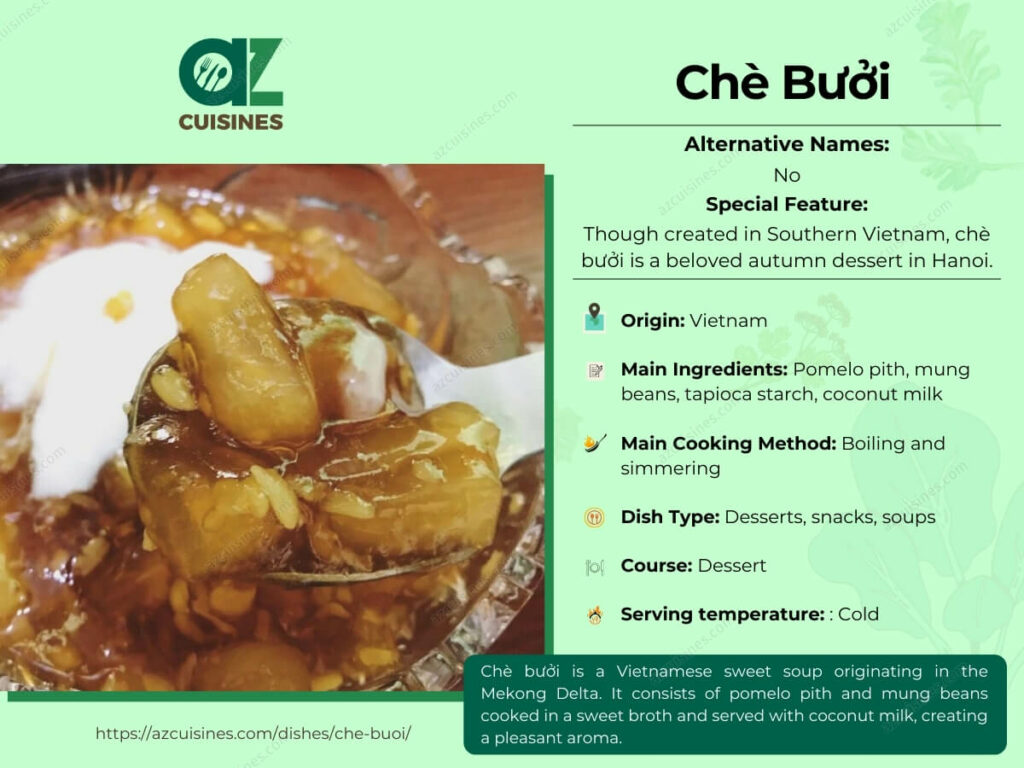Chè Bưởi: Basic Information
Pronunciation
Alternative Name(s)
Dish Type
Course
Mealtime
Popular Variations
Chè Bưởi: Ingredients and Preparation
Main Ingredients
Main Cooking Method
Preparation Process
Chè Bưởi: A Deep Dive
Cultural Significance
Taste
Texture
Aroma
Color
Serving Style
Serving Temperature
Accompaniment
Occasions
Seasons
Special Diets
Calories
Popularity
Popular Similar Dishes
- Bubur Cha Cha
- Thapthim Krop
- Cendol
- Halo-halo
- Tong Sui
Popular Dining Area
Chè bưởi, literally “pomelo sweet soup,” is a traditional Vietnamese sweet soup with roots in the Mekong Delta.
It is also popular in Hanoi as a fall treat, while people in the Mekong Delta serve it year-round. Long Xuyen City in An Giang Province boasts many well-known chè bưởi places.
Chè bưởi is made from pomelo pith (the spongy white part beneath the pomelo rind), split mung beans, coconut milk, and tapioca starch.
Since pomelo pith is very bitter, this ingredient needs to be processed carefully to make this delicate street food.
I will show you an overview of how to make chè bưởi before going into the upsides and downsides of this dessert. Next, I will cover common concerns and similar dishes of this unique sweet soup.
Key Points
How to Make Chè Bưởi?
The process of preparing chè bưởi involves the following 6 steps.
Step 1: Rinsing Pomelo Pith
Remove pomelo pith from the rind and cut it into small cubes. Rinse them carefully with salt water to reduce their bitterness.
Step 2: Parboiling and Marinating Pomelo Pith
Boil the pomelo pith cubes in water with limewater or lime juice. Remove them when the water is clear. Rinse the pomelo pith cubes with water vigorously, then marinate them in sugar.
Step 3: Preparing Mung Beans
Soak split mung beans in water, then steam them until tender.
Step 4: Preparing Pomelo Pith Cubes
Mix the pomelo pith cubes with tapioca starch before boiling them in water. Remove them when the starch is done, then soak them in cold water (to make them crunchy).
Step 5: Cooking Chè Bưởi
Boil sugar and pandan leaves (optional) in water, then add the mung beans, pomelo pith cubes, and additional tapioca starch.
Step 6: Preparing Coconut Milk Sauce
Boil coconut milk with tapioca starch and sugar. Serve the sauce with chè bưởi.
While the preparation process of chè bưởi seems like a bit of a hassle, this dessert soup has many advantages to make up for it. Read on to find out what they are!
Pros and Cons of Eating Chè Bưởi
Chè bưởi has the plus and minus points below.
Pros
Cons




Truc Tran (Kris)
Senior Food Editor
Expertise
Home Cooking, Meal Planning, Recipe Development, Baking and Pastry, Food Editor, Cooking-video Maker, Vietnamese Food Evaluation Expert
Education
Truc Tran (Kris), an experienced food writer and editor, is great at exploring and describing global cuisines, from simple street food to fancy dining. In her writing, she skillfully mixes different flavors, cooking methods, and culinary traditions, showing the unique character of various cultures through their food and drinks. On azcuisines.com, Kris highlights her knowledge, especially in Asian cuisine and worldwide traditional dishes.